Welcome to our comprehensive guide on Arizona’s planting zones and essential tips for maintaining the vibrant beauty of flowers, shrubs, and trees. Whether you’re a seasoned gardener or just starting out, this article will provide invaluable insights into understanding the unique climate variations across Arizona. We hope to equip you with key strategies to ensure your plants thrive in their respective zones. Join us as we uncover the secrets to successful gardening in the Grand Canyon State.
Gardening in Arizona’s Planting Zones
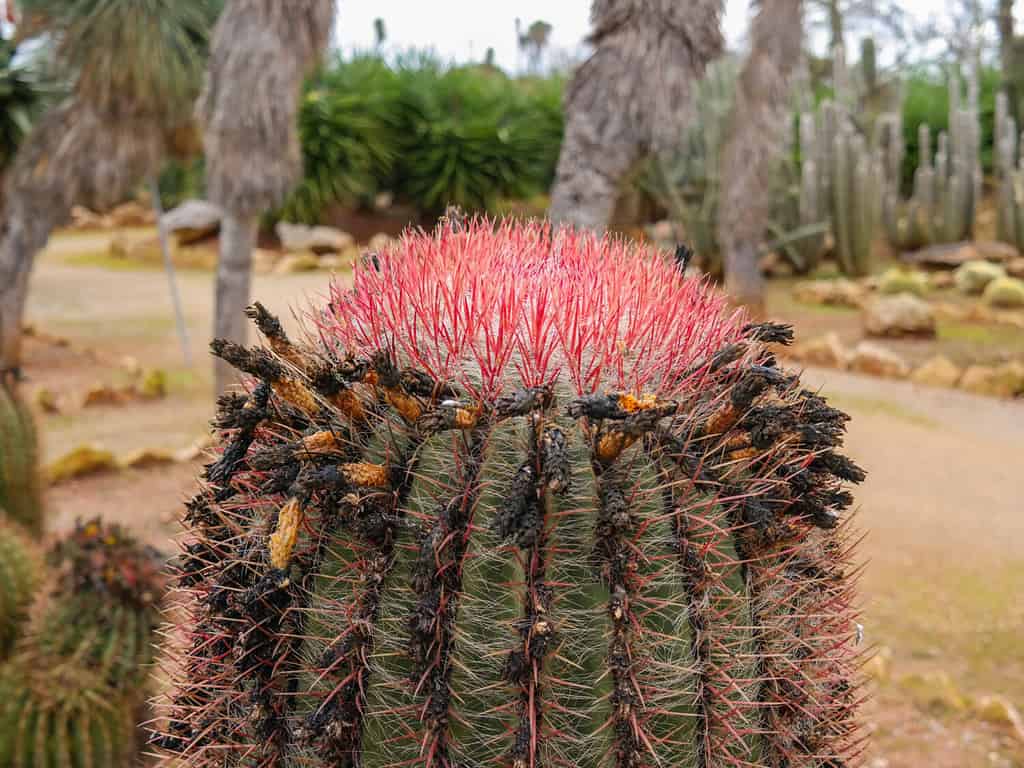
There are many unique and beautiful plants native to Arizona.
©LifeCollectionPhotography/Shutterstock.com
Gardening in Arizona is a unique experience as the weather and climate conditions present their own set of challenges. Arizona is known for its hot, dry summers and mild winters, making it difficult for gardeners to find plants that thrive in the state. Many traditional garden favorites, such as roses, require more moisture than Arizona can provide, and other plants may not survive the extreme temperatures.
In order to be successful, gardeners in Arizona must choose plants that are well-suited for the climate. Cacti, succulents, and other desert-dwelling plants are a great choice for Arizona gardens. Native wildflowers and shrubs can also provide colorful bursts of life in the garden.
For gardeners in the state, water conservation is an important part of gardening. Plants that can survive long dry spells, such as native grasses, are a great choice for Arizona gardens. Mulching can also help retain moisture in the soil, preventing water loss due to evaporation.
Gardening in Arizona also means keeping an eye on pests. Insects that thrive in the hot climate, such as grasshoppers and beetles, can be a nuisance. Gardeners must monitor their plants for signs of infection and take steps to prevent the spread of disease.
Despite the challenges, gardening in Arizona can be incredibly rewarding. With some patience and careful planning, gardeners can create a vibrant oasis in their own backyard. By choosing the right plants and using smart watering practices, gardeners can enjoy the beauty of Arizona’s unique plants and landscapes.
The Regions of Arizona

©Tim Murphy/Shutterstock.com
Arizona’s climate is affected by three distinct geographic regions: the Colorado Plateau, the Transition Zone, and the Basin and Range). The Colorado Plateau occupies the northern part of the state, with elevations between 5,000 to 8,000 feet, and drops off at its southern edge, known as the Mogollon Rim, with a decrease of 2,000 to 3,000 feet. The Transition Zone, also known as the Central Highlands, has rough mountains and flows into the Basin and Range, which covers most of the descending elevations in the south and an area along the Colorado River and north. This zone has warm temperatures year-round and a variety of canyons that create microclimates with drastic changes over short distances. Each of these areas has its own temperature and rainfall patterns that can help people determine what plants will survive best in Arizona.
Arizona’s Planting Zones—Hardiness

USDA Hardiness Zone Map of Arizona
Arizona has a huge range of USDA Hardiness Zones, stretching from 4b to 10b. In the colder areas of zone 4b, temperatures can reach as low as -20°F to -25°F, with Flagstaff in zone 6a experiencing temperatures between -10 and -5°F. The warmest parts of Arizona are mainly located in the south and southwest along the Colorado River and Phoenix metropolitan area, with minimum temperatures around 30°F to 40°F. To keep flowers, shrubs, and trees alive in Arizona, it is important to be aware of these various planting zones and the hardiness of the plants needed to survive in them.
Arizona’s Planting Zones — Heat Index
The American Horticultural Society created the Plant Heat Zone Map in 1997 using data from the National Weather Service recorded between 1974 to 1995. The map is divided into 12 zones based on the number of days with high temperatures above 86°F (30°C), which is assumed to be when plants start to experience serious heat damage. Zone 1 has fewer than one heat day, and Zone 12 has more than 210.
In Arizona, temperatures range from extremely low in the north, with over 15 to 30 days of high heat each year, to scorching in the south, with more than 180 to 210 days of heat annually. Most of the state is classified as zones 4 to 8, with over 14 to 120 days of high temperature. Heat zones are important for plants that are sensitive to hot weather, but there are many native species that love the heat and can survive even when temperatures exceed 86°F.
Arizona’s Planting Zones — Rainfall
The climate in Arizona is usually dry and warm, with yearly rainfall varying from 3 inches in Yuma to 40 inches in the White Mountains. Due to its topography, temperatures vary between areas. In the southwest desert, the average winter day temperatures are in the low 60s, while summer days can get up to over 100 degrees. In higher elevations like Alpine and Greer, the summer temperatures are much cooler, but winter nights can dip into the 20s. June is usually the driest month of the year, with an average statewide precipitation level of 0.30 inches.
On average, Arizona receives 12.26 inches of rain a year. Over the last 30 years, the amount of precipitation has decreased by almost one inch each decade. The state has been suffering from a drought since 1994.
15 Plants That Thrive in Arizona’s Planting Zones
Even with its many challenges, Arizona is home to many beautiful flowers, shrubs, and trees. Here are a few of our favorites.
Daisy

If you live in Arizona, give daisies a try in your garden.
©Christina Duarte/Shutterstock.com
Daisies are beautiful and bright flowers that are easily recognizable. They are low-maintenance, making them a great flower for Arizona gardens. Daisies have a white petal base with a bright yellow center. The petals are often ruffled or fringed. To grow daisies in Arizona, they should be planted in full sun with well-draining soil. Water them when the top inch of the soil is dry, keeping the soil moist but not soggy. Prune them regularly and fertilize them every two weeks.
Columbine
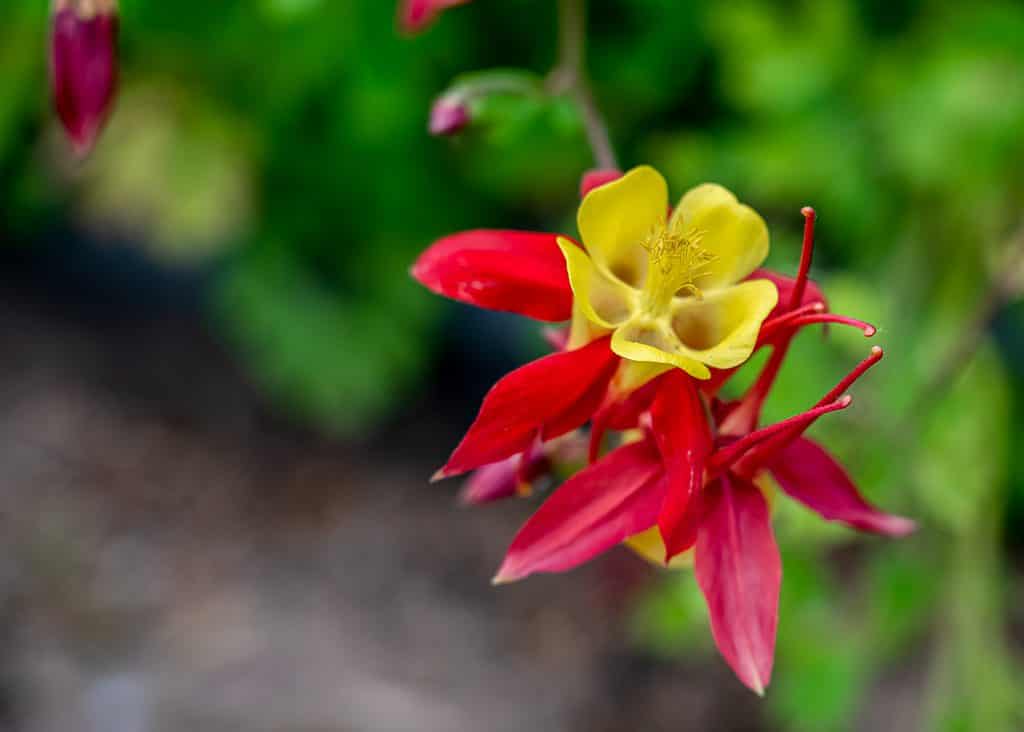
The delicate flowers of columbine look lovely in any garden.
©Martin Hibberd/Shutterstock.com
Columbine is a beautiful flower native to North America. It has graceful, nodding bell-shaped flowers in shades of pink, purple, yellow, and white. Each flower has five petals with spurs that curl outwards. Columbine is a hardy perennial and can thrive in a variety of climates.
In Arizona, columbine prefers semi-shade and needs to be in soil that drains well. To create a lush display, plant them in clumps for maximum impact. A little extra care in providing regular watering and occasional fertilizing can help columbine flourish in the desert.
Marigold
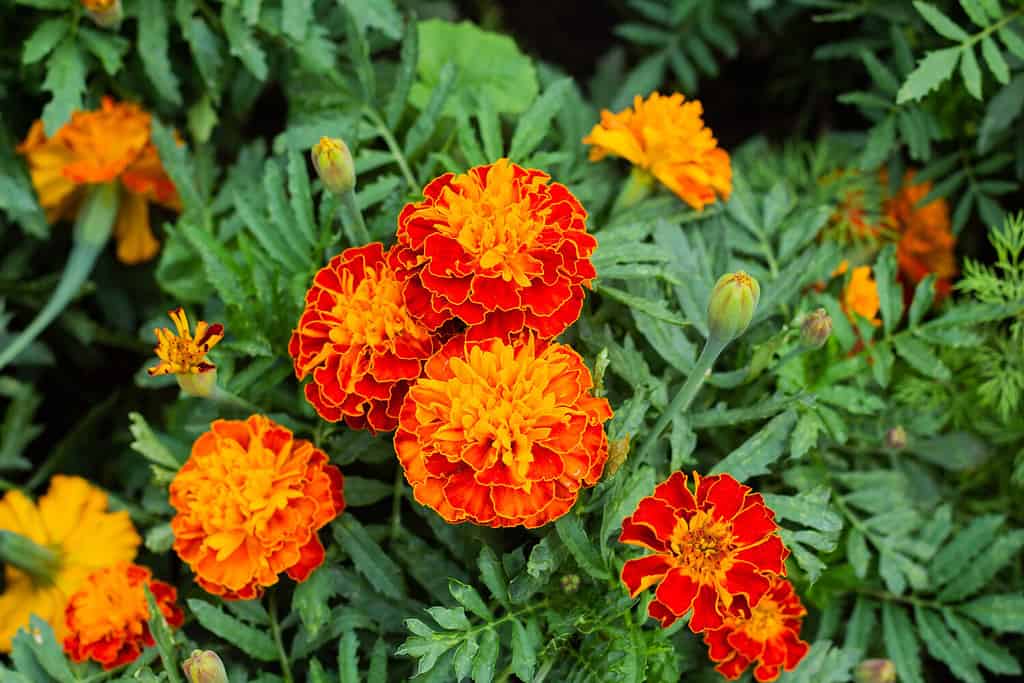
The brilliant-colored blooms of marigolds have the added bonus of deterring insects.
©FunFamilyRu/Shutterstock.com
Marigolds are vibrant and beautiful flowers with a variety of colors and sizes. The colors range from bright yellow and orange to deep reds and purples. They have a unique scent that fills the air with a pleasant aroma. Marigolds are easy to grow in Arizona, thriving in warm and sunny climates. Plant the seeds directly into the ground about a half-inch deep. Water the soil, and the marigolds will quickly sprout and continue to grow. Make sure to keep the soil moist and fertilize the plants regularly.
Primrose
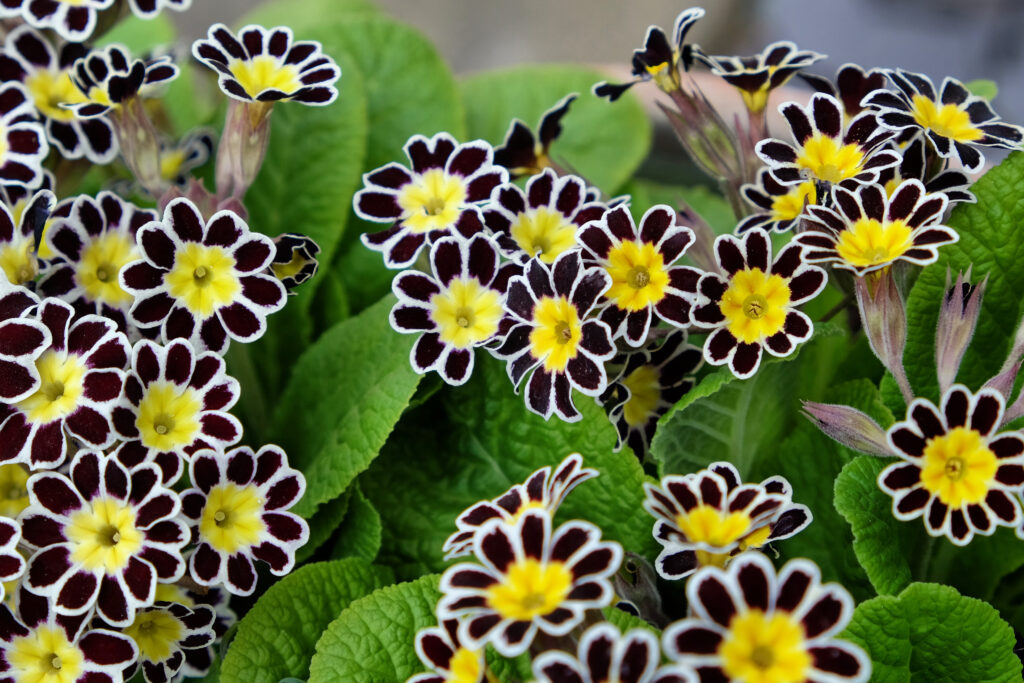
There are a wide array of different colors and patterns of primroses.
©Alex Manders/Shutterstock.com
Primrose is a beautiful, cheerful flower that comes in a wide range of colors and sizes, from delicate white to bold, bright yellow. They are perfect for adding a bit of color to any garden, especially in Arizona. To grow primroses in Arizona, you will need to plant them in a warm, sunny spot with well-drained soil. You will also need to water them regularly and fertilize them at least once a month.
Coreopsis
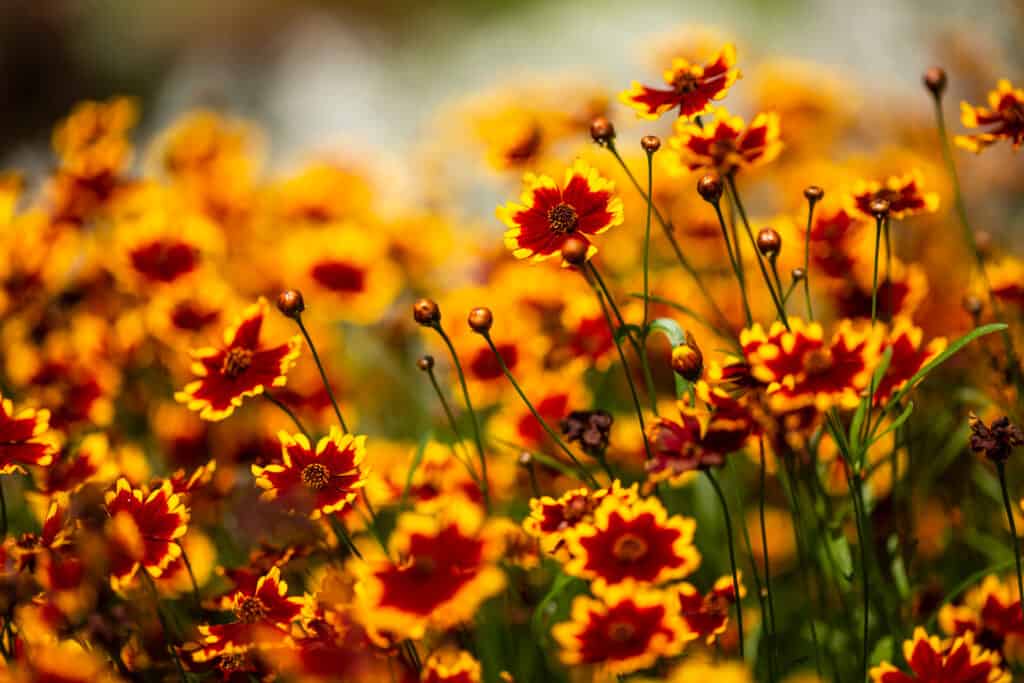
Tickseed, or coreopsis, is an easy-to-care-for perennial.
©RuthG/Shutterstock.com
Coreopsis is an attractive perennial flower that produces showy yellow, orange, and red blooms. It is easy to grow in Arizona, preferring full sun and well-drained soil. It is drought tolerant and will continue to bloom throughout the summer with regular deadheading. Coreopsis can reach up to 3 feet tall and has a long blooming season from spring to fall. It is a great addition to any sunny flower bed or garden. Propagation is easy and can be done by division or from seed. Planting in spring is best, and with regular deadheading and fertilizing, coreopsis will thrive in Arizona.
Euphorbia

There are many types of Euphorbias that are succulent and thrive in Arizona.
©iStock.com/Rawf8
Euphorbia is a succulent plant that is ideal for growing in Arizona due to its heat and drought tolerance. They have a unique appearance, with multiple branches and textured leaves. The leaves are often in a pointed star shape and can be green or grayish-blue in color. Euphorbia also produces small yellow flowers, which add to its beauty. To grow euphorbia in Arizona, choose a sunny spot and well-draining soil. Euphorbia needs regular watering when temperatures are hot but can go longer periods without water when temperatures are cooler. Make sure to protect the plant from frost and cold temperatures. Additionally, fertilize every few weeks to promote healthy growth.
Sage

Several different types of sage thrive in Arizona.
©Beach Creatives/Shutterstock.com
Sage is an evergreen shrub with grayish-green leaves and small purple flowers. It is native to Arizona and grows best in full sun. It requires well-drained soil with regular watering. When planting, make sure to space the plants at least two feet apart to give them enough room to grow. Prune the sage shrub regularly, removing any dead or diseased branches. This will help it stay healthy and promote new growth. Sage is a drought-tolerant shrub and can thrive in the desert heat of Arizona.
Agave

Fields of blue agave plants are a beautiful sight to behold.
©javarman/Shutterstock.com
Agave is a sun-loving plant that grows best in the warm planting zones of Arizona. Its succulent leaves are thick and have sharp pointed tips, and its base has a rosette shape. It can be grown from seeds, offsets, or pups. To grow agave in Arizona, plant it in full sun and well-draining soil, and water it sparingly. It is important to protect the plant from frost and cold temperatures. Fertilize the plant sparingly with a balanced fertilizer, and prune off any dead leaves or flower stalks. With proper care, agave can be a beautiful and low-maintenance addition to any desert landscape.
Yucca
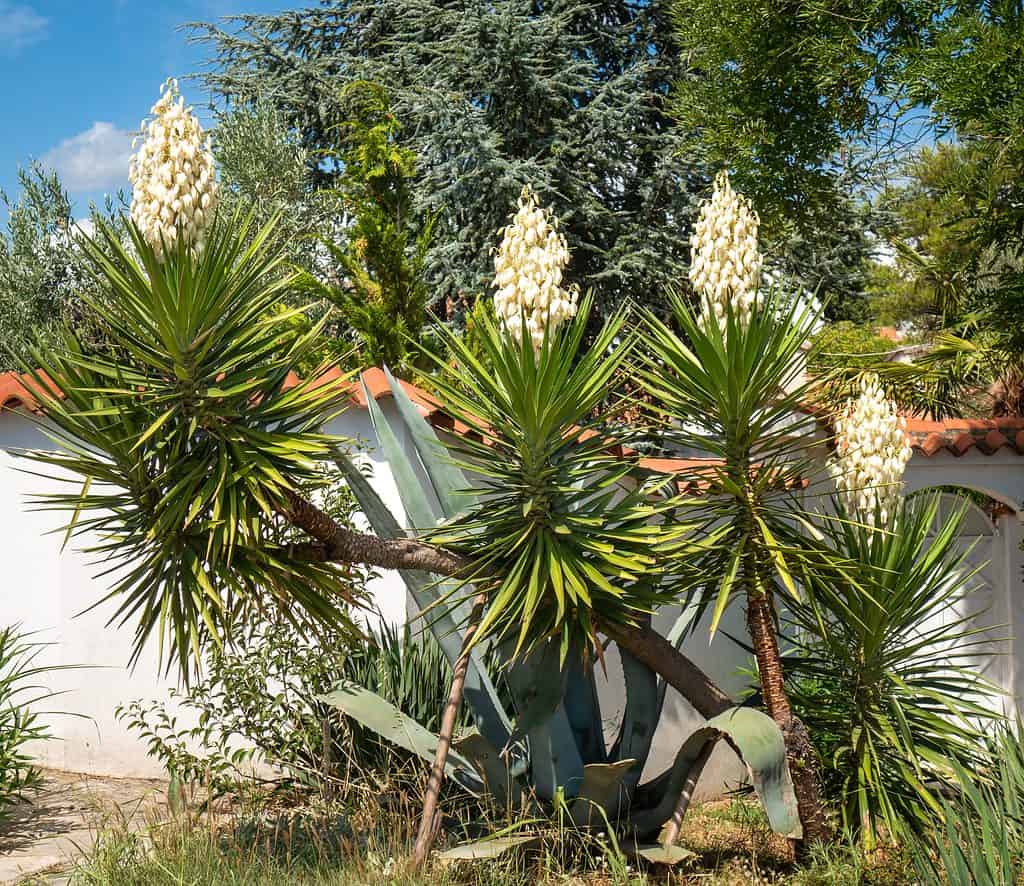
Some species of yucca plants get truly gigantic.
©Peter Klampfer/Shutterstock.com
Yucca is a beautiful, low-maintenance desert plant with spiky green leaves. It is native to the Southwest United States, including Arizona, and is known for its hardy nature and ability to thrive in dry climates. It requires minimal care and watering and can survive in temperatures as low as -10°F. To grow yucca in Arizona, it is best to plant it in well-draining soil with full sun exposure and little to no shade. Water the plant deeply but infrequently, allowing it to dry out between waterings. With proper care, yucca plants can provide years of vibrant color and texture to any landscape.
Juniper
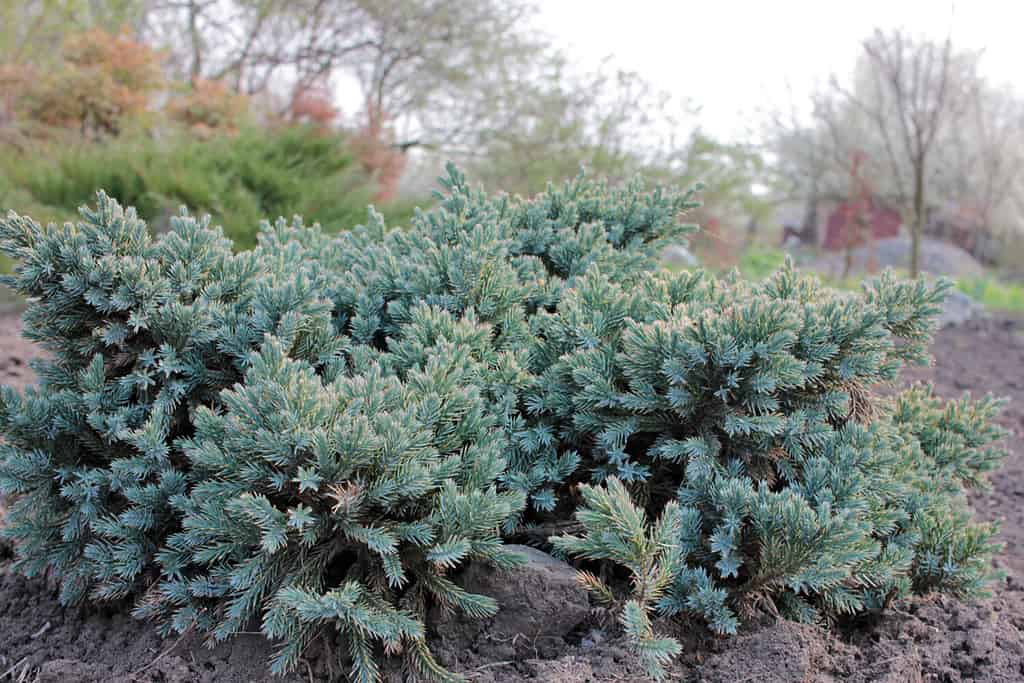
Wildlife loves juniper shrubs for their small berries.
©Juver/Shutterstock.com
A juniper shrub is a beautiful and hardy evergreen that can add texture and color to any landscape. It is an easy-to-grow plant with attractive blue-green foliage and can be found in many different varieties. Growing juniper in Arizona is simple, as it does well in dry, rocky, and sandy soils. It requires full sun and is drought-tolerant, making it an ideal plant for the hot, dry desert climate. Junipers can be pruned into a shrub or left to grow as a small tree and can reach heights of up to 8 feet. To get the best results, prune it in the early spring and water deeply once a week.
Pine Tree
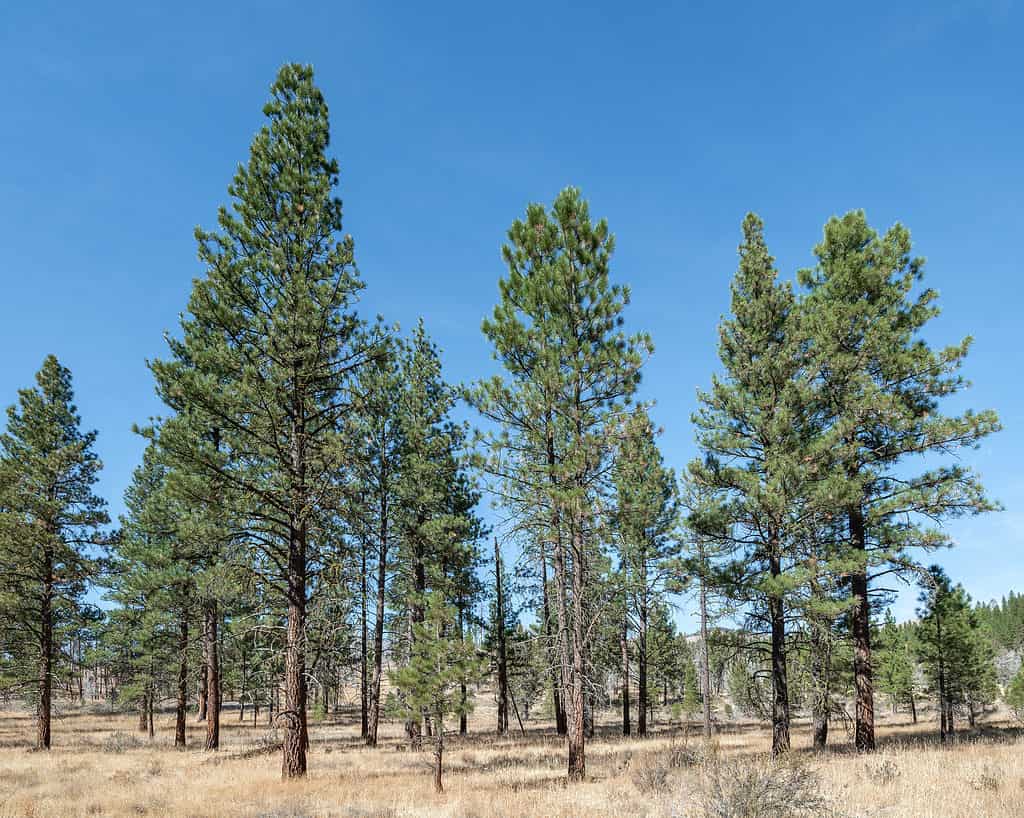
A stand of ponderosa pine trees is very drought-tolerant once established.
©Dominic Gentilcore PhD/Shutterstock.com
Pine trees are evergreen conifers that can grow up to hundreds of feet tall, with needles that give off a pleasant aroma. They can be found in many parts of the world, including Arizona. To grow a pine tree in Arizona, you need to choose a species that is hardy to the area, such as Ponderosa or Chihuahua pine. Plant seedlings in a sunny location and water regularly. Be sure to give the trees plenty of room to grow and prune back the branches as needed.
Mesquite Tree
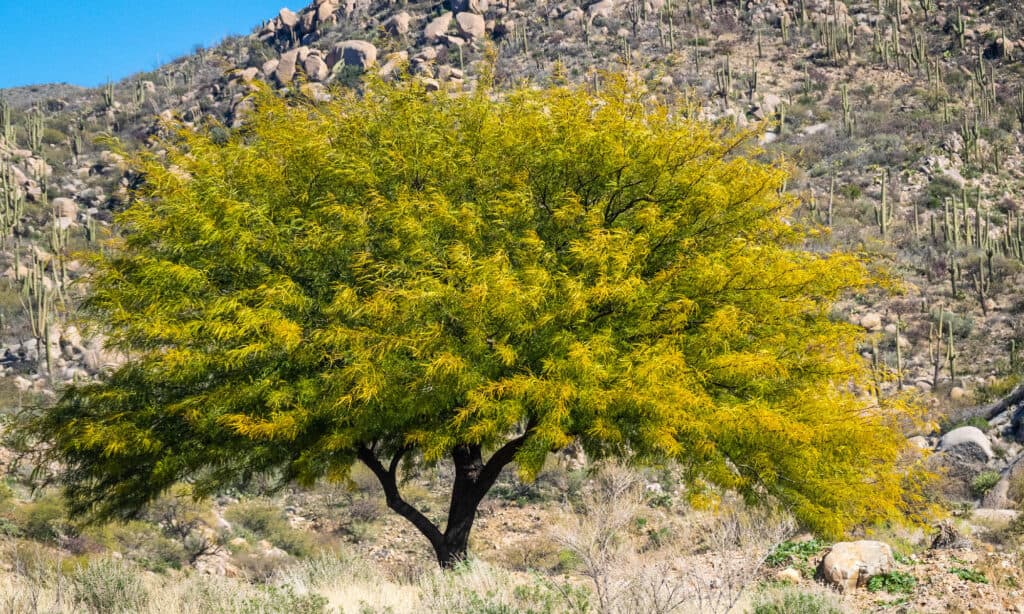
A gorgeous mesquite tree is a great addition to a low-water garden.
©Eugenie Robitaille/Shutterstock.com
Mesquite trees are small to medium-sized perennial shrubs native to the deserts of Arizona and the surrounding area. They are often characterized by their twisted and gnarled trunks and their attractive, feathery foliage. These hardy trees can survive in arid climates with minimal water and care. To grow a mesquite tree in Arizona, plant in full sun and provide regular irrigation during the first few years of growth. Ensure the soil is well-draining and avoid over-watering. Prune the trees as needed to maintain their shape and health.
Acacia Tree
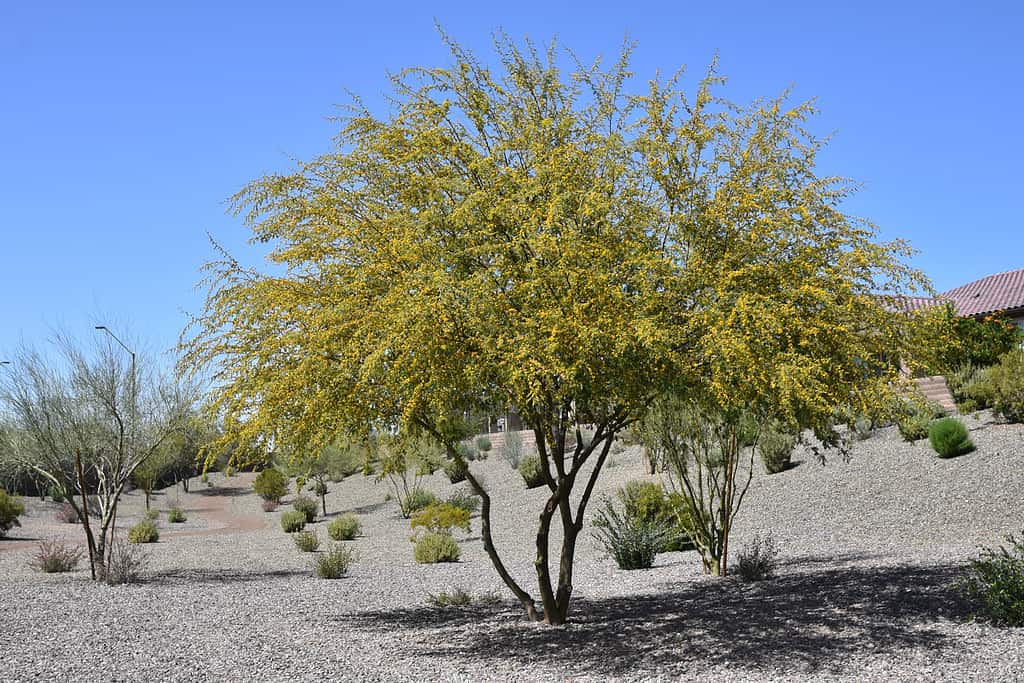
Sweet acacia loves hot, sunny climates.
©Thomas Trompeter/Shutterstock.com
Acacia trees are beautiful flowering plants native to tropical regions. They are large, bushy trees with thick trunks and delicate foliage. Their leaves are small and feathery, and they produce beautiful yellow or white blooms. To grow acacia trees in Arizona, they should be planted in full sun and kept well-watered. Acacia trees are drought-tolerant once established and can take temperatures down to 20 degrees Fahrenheit.
Cottonwood Tree

Most people forget about cottonwood trees, but they are great for desert landscaping.
©C Belt/Shutterstock.com
Cottonwood trees are deciduous trees with large, heart-shaped leaves and light gray, craggy bark. They can reach heights of up to 70 feet and have a wide, spreading canopy. In Arizona, cottonwood trees prefer full sun and moist, well-drained soil. Planting in spring or late fall allows for the best growth and health of the tree. Watering regularly, especially during the summer, will help the tree to establish itself. Pruning should be done in the late winter or early spring to encourage new, healthy growth.
Palo Verde Tree
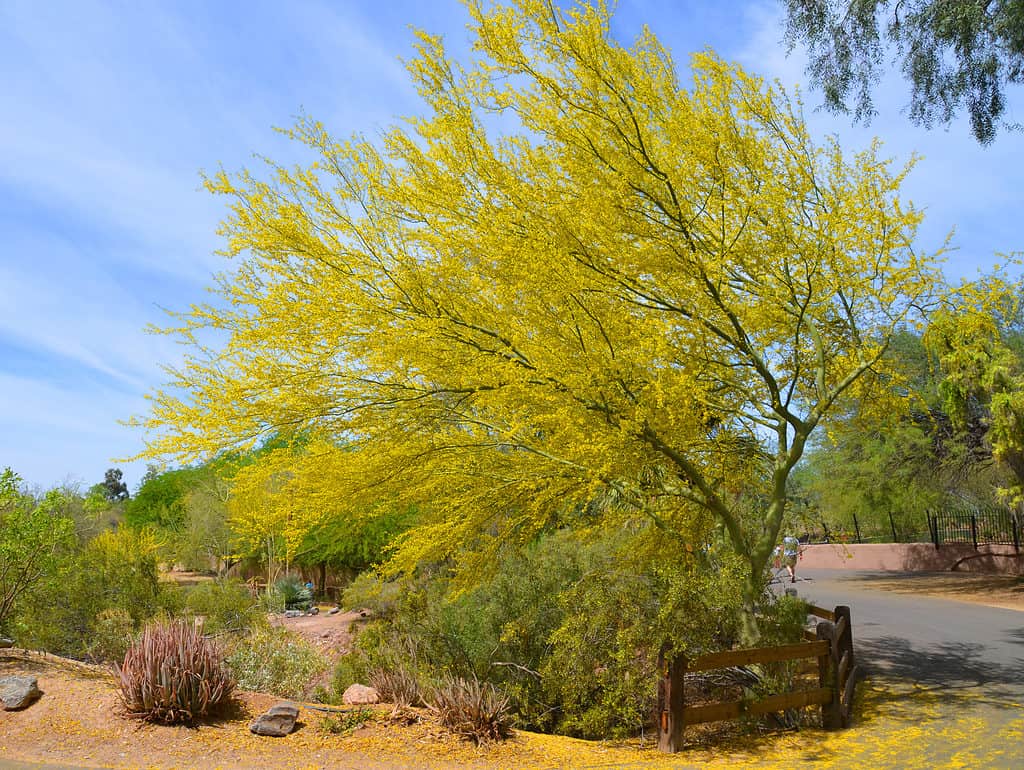
The blue palo verde bursts into color with bright yellow leaves in the spring.
©meunierd/Shutterstock.com
Palo Verde is a type of tree that is native to the southwestern United States. It has a distinct yellow-green bark that gives it its name. Palo Verde has a canopy of bright green, fern-like foliage and produces vibrant yellow flowers in springtime. It is a popular tree for landscaping in the desert, as it is drought tolerant and needs little water once established. To grow Palo Verde in Arizona, it is best to plant it in a sunny spot with well-draining soil. Irrigate it every few weeks during the first year, and then reduce the frequency of watering as the tree matures.
10 Keys To Keeping Flowers, Shrubs, and Trees Alive in Arizona’s Planting Zones
- Ensure adequate sunlight.
- Plant in well-draining soil.
- Water regularly. Have an irrigation plan before you plant!
- Prune regularly to promote healthy growth.
- Fertilize with a balanced fertilizer.
- Mulch around plants to conserve moisture.
- Protect from extreme temperatures.
- Monitor for pests and diseases.
- Use plants that are native to Arizona’s planting zones.
- Select the right plant for the right place.
Thank you for reading! Have some feedback for us? Contact the AZ Animals editorial team.








